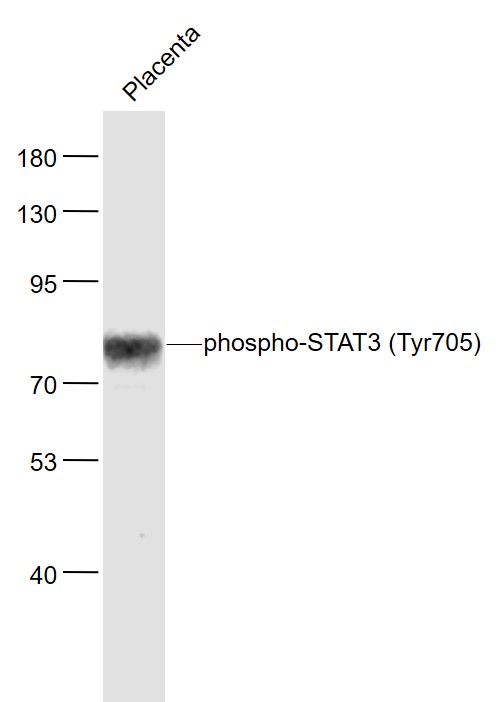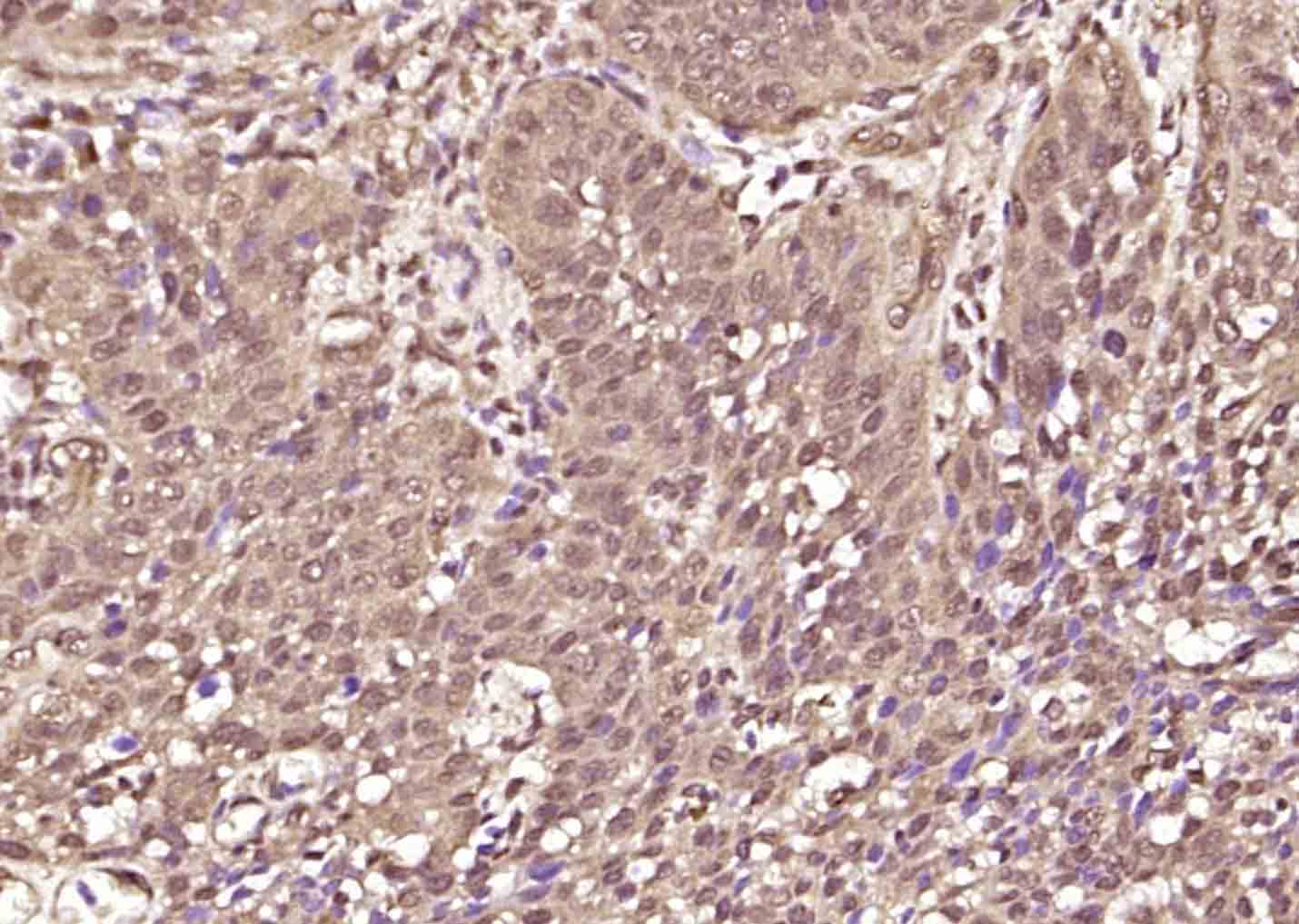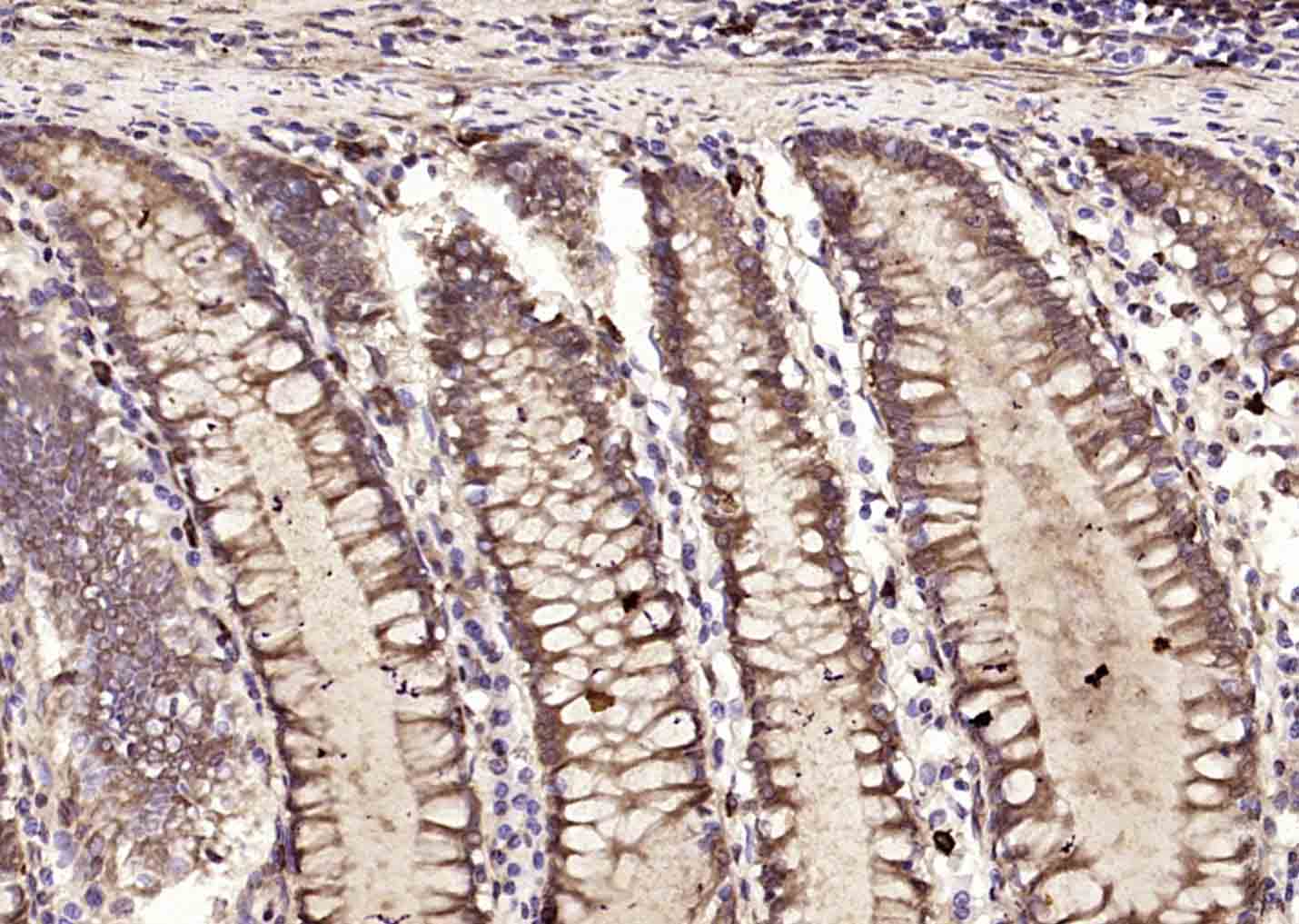
Rabbit Anti-phospho-STAT3 (Tyr705)antibody
STAT3 (phospho Y705); p-STAT3 (phospho Y705); Phospho-Stat3(pTyr705); STAT3(Phospho-Tyr705); p-STAT3(Tyr705); Phosphorylated Stat3(pTyr705); p-Stat3; Acute Phase Response Factor; APRF; DNA binding protein APRF; FLJ20882; MGC16063; Signal Transductor and A
View History [Clear]
Details
Product Name phospho-STAT3 (Tyr705) Chinese Name 磷酸化Signal transduction和转录激活因子3抗体 Alias STAT3 (phospho Y705); p-STAT3 (phospho Y705); Phospho-Stat3(pTyr705); STAT3(Phospho-Tyr705); p-STAT3(Tyr705); Phosphorylated Stat3(pTyr705); p-Stat3; Acute Phase Response Factor; APRF; DNA binding protein APRF; FLJ20882; MGC16063; Signal Transductor and Activator of Transcription 3; STAT 3; STAT3_HUMAN. literatures Product Type Phosphorylated anti Research Area Tumour Cardiovascular Cell biology immunology Signal transduction Stem cells Apoptosis transcriptional regulatory factor Epigenetics Immunogen Species Rabbit Clonality Polyclonal React Species Human, Mouse, (predicted: Rat, Chicken, Dog, Pig, Cow, Rabbit, Sheep, Guinea Pig, ) Applications WB=1:500-2000 IHC-P=1:100-500 IHC-F=1:100-500 ICC=1:100-500 IF=1:100-500 (Paraffin sections need antigen repair)
not yet tested in other applications.
optimal dilutions/concentrations should be determined by the end user.Theoretical molecular weight 85kDa Cellular localization The nucleus cytoplasmic Form Liquid Concentration 1mg/ml immunogen KLH conjugated Synthesised phosphopeptide derived from human STAT3 around the phosphorylation site of Tyr705: AP(p-Y)LK Lsotype IgG Purification affinity purified by Protein A Buffer Solution 0.01M TBS(pH7.4) with 1% BSA, 0.03% Proclin300 and 50% Glycerol. Storage Shipped at 4℃. Store at -20 °C for one year. Avoid repeated freeze/thaw cycles. Attention This product as supplied is intended for research use only, not for use in human, therapeutic or diagnostic applications. PubMed PubMed Product Detail STATs (signal transducers and activators of transcription) were originally discovered as two proteins (STAT1 and STAT2) which were involved in interferon alpha (IFN alpha) and IFN gamma signal transduction. Since then, several additional STAT proteins have been identified (STAT3, 4, 5a, 5b, and 6). STATs undergo tyrosine phosphorylation in response to growth factor or cytokine signaling. This phosphorylation results in dimerization and translocation of STAT proteins to the nucleus. In some cases this process is mediated by JAK Kinases (Janus Kinases 1, 2, and 3). For maximum activation of these proteins, phosphorylation at specific tyrosine and serine residues may be required in STAT1 alpha, 3, 4, and 5.
Specific functions of the various members of the STAT family are poorly understood. STAT3 has been shown to be activated by IFN alpha but not IFN beta. The transcription factors associated with STAT3 are cJun and cyclic AMP responsive enhancer binding protein (CREB). Deletion of the STAT3 gene in knock out mice was lethal at the early embryonic stage.
STAT1 and STAT2 are induced by IFN alpha and forn 1, a heterodimer which is part of the ISGF transcription factor complex. The STAT3 protein is expressed in most cell types and is activated by multiple cytokines and growth factors including: IFNa, IL10, IL6, IL11, IL12, IL2, EGF, among others. STAT3 beta appears to be activated by both EGF and IL6, but STAT3 alpha is only activated by EGF. STAT3 binds to DNA as either a homodimer or as a heterodimer with STAT1. STAT3 interacts with the APRE acute phase response element) and SIE (csis inducible element). STAT4, predominantly expressed in testis and myeloid cells, is activated by ILl2. STAT5 is activated by prolactin and IL3. STAT6 participates in signaling pathways mediated by IL4.
Function:
Transcription factor that binds to the interleukin-6 (IL-6)-responsive elements identified in the promoters of various acute-phase protein genes. Activated by IL31 through IL31RA.
Subcellular Location:
Cytoplasm. Nucleus. Shuttles between the nucleus and the cytoplasm. Constitutive nuclear presence is independent of tyrosine phosphorylation. Predominantly present in the cytoplasm without stimuli. Upon leukemia inhibitory factor (LIF) stimulation, accumulates in the nucleus. The complex composed of BART and ARL2 plays an important role in the nuclear translocation and retention of STAT3.
Tissue Specificity:
Heart, brain, placenta, lung, liver, skeletal muscle, kidney and pancreas.
Post-translational modifications:
Tyrosine phosphorylated upon stimulation with EGF (By similarity). Tyrosine phosphorylated in response to IL-6, IL-11, CNTF, LIF, CSF-1, EGF, PDGF, IFN-alpha and OSM. Phosphorylated on serine upon DNA damage, probably by ATM or ATR. Serine phosphorylation is important for the formation of stable DNA-binding STAT3 homodimers and maximal transcriptional activity. ARL2BP may participate in keeping the phosphorylated state of STAT3 within the nucleus.
DISEASE:
Defects in STAT3 are the cause of hyperimmunoglobulin E recurrent infection syndrome autosomal dominant (AD-HIES) [MIM:147060]; also known as hyper-IgE syndrome or Job syndrome. AD-HIES is a rare disorder of immunity and connective tissue characterized by immunodeficiency, chronic eczema, recurrent Staphylococcal infections, increased serum IgE, eosinophilia, distinctive coarse facial appearance, abnormal dentition, hyperextensibility of the joints, and bone fractures.
SWISS:
P40763
Gene ID:
6774
Database links:Entrez Gene: 6774 Human
Entrez Gene: 20848 Mouse
Omim: 102582 Human
SwissProt: P40763 Human
SwissProt: P42227 Mouse
Unigene: 463059 Human
Product Picture
Placenta (Mouse) Lysate at 40 ug
Primary: Anti- phospho-STAT3 (Tyr705) (SL22386R) at 1/1000 dilution
Secondary: IRDye800CW Goat Anti-Rabbit IgG at 1/20000 dilution
Predicted band size: 85 kD
Observed band size: 80 kD
Paraformaldehyde-fixed, paraffin embedded (human laryngeal carcinoma); Antigen retrieval by boiling in sodium citrate buffer (pH6.0) for 15min; Block endogenous peroxidase by 3% hydrogen peroxide for 20 minutes; Blocking buffer (normal goat serum) at 37°C for 30min; Antibody incubation with (phospho-STAT3 (Tyr705)) Polyclonal Antibody, Unconjugated (SL22386R) at 1:200 overnight at 4°C, followed by operating according to SP Kit(Rabbit) (sp-0023) instructionsand DAB staining.Paraformaldehyde-fixed, paraffin embedded (human colon carcinoma); Antigen retrieval by boiling in sodium citrate buffer (pH6.0) for 15min; Block endogenous peroxidase by 3% hydrogen peroxide for 20 minutes; Blocking buffer (normal goat serum) at 37°C for 30min; Antibody incubation with (phospho-STAT3 (Tyr705)) Polyclonal Antibody, Unconjugated (SL22386R) at 1:200 overnight at 4°C, followed by operating according to SP Kit(Rabbit) (sp-0023) instructionsand DAB staining.
References (0)
No References
Bought notes(bought amounts latest0)
No one bought this product
User Comment(Total0User Comment Num)
- No comment





 +86 571 56623320
+86 571 56623320
 +86 18668110335
+86 18668110335

